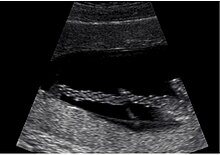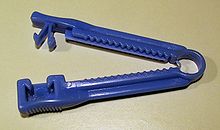umbilical cord

The umbilical cord , anatomically known as the funiculus umbilicalis , connects the embryo or fetus with the placenta in the womb of placental animals , including most of today's mammals as well as humans , besides monotones and marsupials . In the umbilical cord vessels in the fetal blood circulation, the blood flows arterially to and venously back from the placenta, where especially carbon dioxide as well as nutrients and oxygen are exchanged with the blood circulation of the mother or the pregnant woman.
Layout and function
In a full-term baby, the human umbilical cord is about 50–60 centimeters long, 1.5–2 centimeters in diameter, usually spirally wound and surrounded by the amnion . It initially contains four blood vessels, of which the right umbilical vein recedes between the 28th and 32nd day of embryonic development. Thereafter, the umbilical cord usually has three vessels, two umbilical arteries ( arteriae umbilicales ), which carry carbon dioxide-rich and nutrient-poor blood from the child to the placenta , and an umbilical vein ( vena umbilicalis ), which carries blood from the placenta to the child. Typical of the umbilical cord is the gelatinous connective tissue , which is responsible on the one hand for the necessary flexibility and at the same time protects against kinking in the event of bending loads. It consists of fine collagens , a few fibroblasts and large amounts of water-binding hyaluronic acid ( Wharton's jelly ).
If only one umbilical artery is detectable, one speaks of a singular umbilical artery . Such an umbilical cord with two instead of three vessels occurs as a rare variant in humans (about one percent); here the statistical risk of malformation in other organs is increased by a factor of 1.3–1.6. Short umbilical cords are also associated with an increased risk of malformations; for example, the movements of the fetus may be reduced due to disorders of the central nervous system or muscles. Long umbilical cords increase the risk of a knot or prolapse of the umbilical cord.
Umbilical cord after birth
In the medically assisted birth of a person, the umbilical cord is usually tied off or - with an umbilical cord clamp - pinched off and then cut. Different times of the so-called cord removal can be selected for this. In most animals, the mother bites the umbilical cord or it breaks off on its own. After the dried up umbilical cord has fallen off - after about three to ten days - a scar appears in the middle of the abdomen and the belly button heals .
Waiting for the umbilical cord to fall off with the afterbirth still attached is also called a lotus birth .
Blood can be taken from the insensitive umbilical cord without pain for the newborn. Umbilical cord blood stem cells can be obtained from the umbilical cord blood .
Complications
During pregnancy as well as during childbirth, so-called umbilical cord complications such as umbilical cord looping , umbilical cord knots or umbilical cord prolapse can occur . An omphalocele as an umbilical cord break or umbilical cord hernia is also possible.
Others
In technical terms, special supply hoses or cables are called umbilical cables (English for "umbilical cord"). These are used, for example, in space travel when refueling rockets , or they connect an astronaut's space suit with the life support systems during an outboard activity in space or serve to supply a diver with air while umbilical cord diving .
literature
- Alex Novotny: Gynecology, Obstetrics and Neonatology: Textbook for Nursing Professions. W. Kohlhammer Verlag, 2006, ISBN 3-17-018346-X , p. 208.
- Jörg Baltzer, Klaus Friese , Michael Graf, Friedrich Wolff: Practice of gynecology and obstetrics: the complete practical knowledge in one volume. Georg Thieme Verlag, 2006, ISBN 3-13-144261-1 , p. 294.
Individual evidence
- ↑ Peter W. Callen: Ultrasonography in Obstetrics and Gynecology. Saunders, 2000, ISBN 0-7216-8132-8 , p. 618.
- ^ A b Peter W. Callen: Ultrasonography in Obstetrics and Gynecology. Saunders, 2000, ISBN 0-7216-8132-8 , p. 619.



